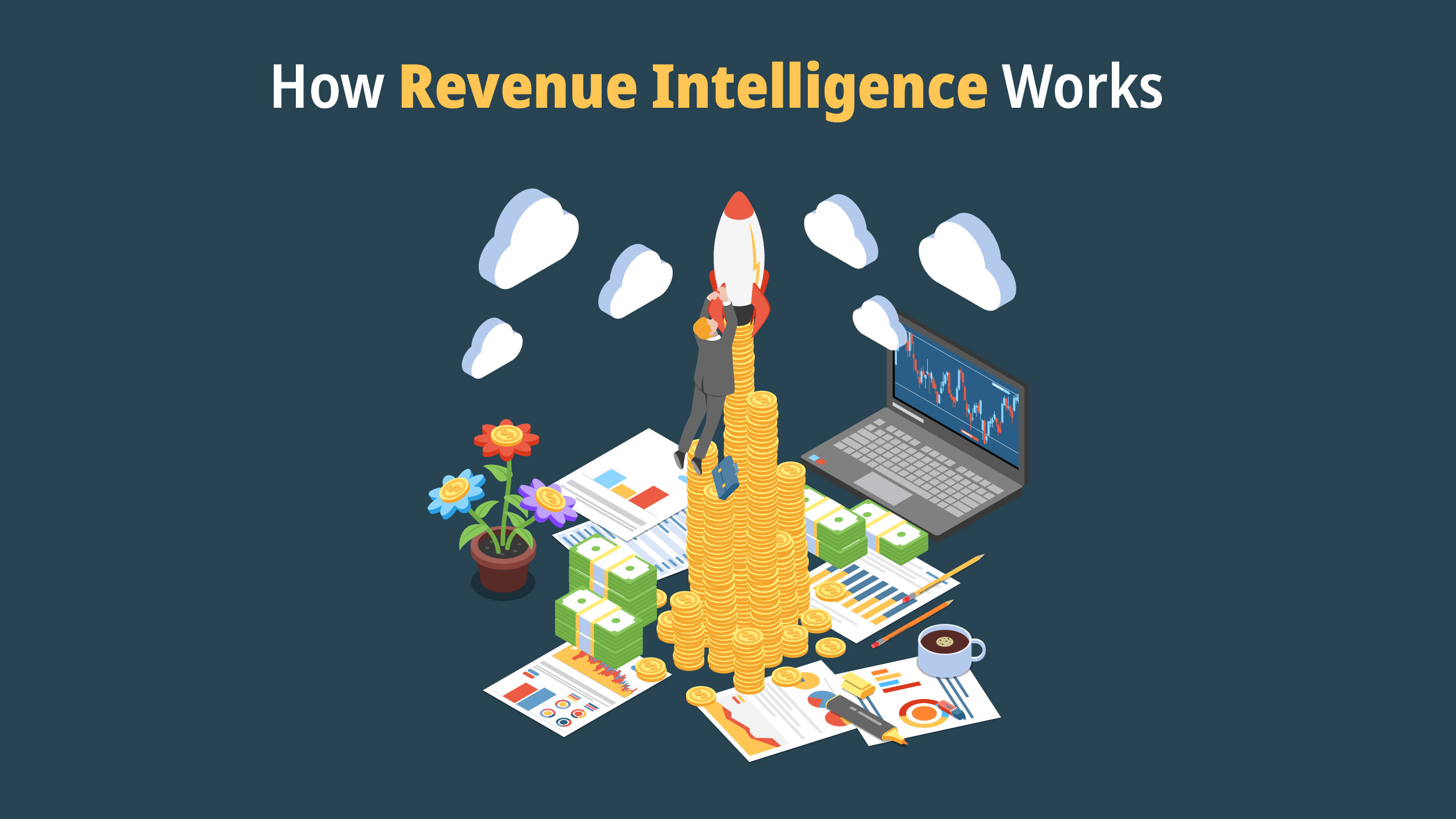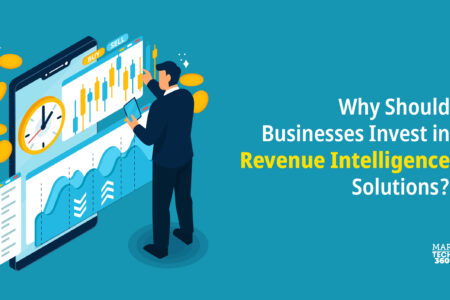In the race to outshine rivals, and boost their revenue, businesses are always looking for effective strategies. One powerful approach is leveraging revenue intelligence. It involves collecting, analyzing, and interpreting sales data to inform strategic business decisions.
Forrester recently highlighted the importance of this approach, declaring that revenue intelligence is “core to a go-to-market tech stack.”
Let’s explore this process further in this article.
What is Revenue Intelligence?
Revenue intelligence is an AI-powered procedure for gathering and examining sales data. With the help of this process data, sales teams can close revenue gaps and meet their quotas and sales projections.
Customer revenue optimization and tracking progress toward goal metrics is the process this software follows. Insights from that analysis are presented in the same CRM that the sales team uses. These insights can be available in many different forms, such as deal dashboards to prioritize, action alerts and suggestions, sales and forecast trend visualizations, and team performance leaderboards for important KPIs.
How Revenue Intelligence Works

Data Collection & Integration
Gathering information from several sources inside your revenue tech stack—CRM, marketing automation, and communication platforms—is the first step towards utilizing this process. In addition to smoothly integrating with these platforms through pre-built integrations or APIs, advanced software also works in tandem with conversation intelligence and sales engagement solutions.
By combining data into a single, centralized repository, this integration creates a strong revenue orchestration platform that improves visibility into every customer interaction and makes more coherent, AI-driven analytics possible.
Data Cleansing & AI Analysis
After being compiled, the data is cleaned to get rid of duplicates, standardize formats, and add third-party intelligence to records. Subsequently, sophisticated machine learning models scrutinize the combined dataset, pinpointing interconnections and indicators that signify deal momentum, buyer inclination, and representative performance.
Surfacing Insights & Recommendations
This information is then bundled by the revenue intelligence platform into easily assimilated formats such as guided selling plays, automated alerts, and visual dashboards. Sales managers are able to see the health of the pipeline and identify problem areas quickly. Representatives get coaching on how to maximize interactions with customers. Based on the most recent predictions made by AI, quotas and forecasts are revised on a regular basis.
Closed-Loop Learning
The data collection method incorporates user activity when they take actions based on insights from the platform. The AI models in the system are able to learn and get better over time thanks to this never-ending cycle of data acquisition, cleansing, analysis, and enabling.
The intelligent workflow facilitated by this method enables sales teams to make more data-driven and scientific decisions, whether they are integrated into CRM or used as standalone applications.
Benefits of Revenue Intelligence
In 2024, revenue intelligence will be a broad and significant discipline for go-to-market teams.
Data-driven decision making: It gives companies useful information and insights to assist them decide on anything from which accounts to target to how best to conduct sales discussions.
More accurate forecasting: According to InsightSquared, 68% of companies miss their forecast by 11% or more. Revenue forecasting and consistency are crucial for organizational planning. With less room for human mistakes, it helps firms predict revenue and pipeline swiftly and precisely.
Competitive advantage: Companies that successfully use this method can surpass their rivals by continuously enhancing their revenue operations and sales.
Alignment with market developments: Real-time data can help organizations respond quickly to shifts in the competitive landscape. This may entail changing objection-handling techniques or pricing methods.
If this fits with your company’s objectives, it could be time to look into revenue intelligence software. We’ve compared a few below to help you understand which providers are available and what’s feasible.
Also Read: How Are Sales Analytics The Backbone Of Revenue Generation
5 Best Revenue Intelligence Software in 2024
Listed below are some of the best software you can consider this year.
1. Gong
One of the most favored tools available is Gong, which offers complete insight into your client relationships and sales interactions. Teams can identify pipeline risk, create projections, mentor sales representatives, examine sales interactions, and more using Gong.
2. Salesloft
With clients like Greenhouse, IBM, Shopify, and Stripe, Salesloft is another well-known AI-powered revenue intelligence platform. Teams can estimate sales outcomes, manage pipelines, monitor conversations, and create cadences with Salesloft.
3. Groove
Groove is an all-in-one solution that was recently acquired by Clari. With its analytics features, opportunity management tools, coaching features, and other features, it’s no wonder that sales teams looking to boost productivity frequently go for it.
4. Apollo.io
With capabilities to assist you in prospecting, engaging, and increasing revenue, Apollo.io is an all-in-one sales intelligence platform. Sales and marketing teams utilize it frequently to find new leads, guide outreach, and maintain pipelines.
5. Revenue.io
Revenue.io, formerly known as RingDNA, is a full-featured platform that provides coaching, pipeline management, conversation analysis, and more.
Tips for Successful Revenue Intelligence Implementation
Define Success Clearly
- Establish specific, measurable goals linked to key sales targets.
- Use metrics like pipeline acceleration, quota attainment, average deal size, customer churn, and overall revenue growth.
- Benchmark current performance to measure improvement post-implementation.
- Develop a phased roadmap with progress checkpoints to ensure targeted, data-driven initiatives.
Choose the Right Platform
- Understand platform capabilities, from simple dashboards to advanced machine learning.
- Ensure seamless integration with your CRM and other tools.
- Prioritize user-friendly interfaces and mobile accessibility for maximum adoption.
Secure Stakeholder Buy-In Early
- Engage leaders from marketing, sales, service, and success teams.
- Highlight how revenue intelligence benefits their specific goals.
- Involve them in planning and find executive sponsors to support the initiative.
- Address frontline concerns and build a unified vision for revenue intelligence.
Integrate Data Sources
- Connect the platform with all relevant sales, marketing, and customer systems.
- Use pre-built connectors where possible and customize as needed.
- Ensure historical data from legacy systems is included.
- Design robust integration pipelines to enhance analytical capabilities over time.
To Conclude
Revenue intelligence is a powerful tool for modern businesses to gain deeper insights into their sales processes, customer interactions, and overall revenue generation. By leveraging advanced technology and data analytics, companies can uncover valuable patterns, trends, and opportunities that can significantly impact their bottom line. From optimizing pricing strategies to identifying cross-selling opportunities, this process empowers organizations to make informed decisions that drive growth and profitability. As the business landscape continues to evolve, embracing this method will be crucial for staying competitive and thriving in an increasingly data-driven world. It’s clear that the future belongs to those who harness the power of revenue intelligence to unlock hidden potential within their operations.

